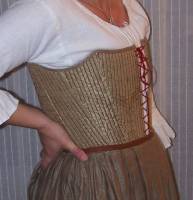 Manteau
(about 1686)
Manteau
(about 1686)The manteau, or mantua, emerged around 1680 as comfortable house dress of the ladies of the French court. It's the ancestor of the
Robe à la Française and the Robe à l'Anglaise. The waterfall train is its most fetching feature.
The robe is made of gold-beige silk taffeta, the skirt of sand-coloured silk taffeta. Mostly hand-stitched. Approximate size 42-44 (DE, NL, AT, CH, ES), 14-16 (US), 16-18 (UK)
More pics here
![]() Empire
dress (about 1805)
Empire
dress (about 1805)
Pattern reproduces an original of about 1805 in Weimar. Dark green
cotton with small white flowers. Size about 44 (DE, NL, AT, CH, ES), 16
(US), 18 (UK)
More pics here.
 Empire
dress with under-dress and Peplos (about 1805)
Empire
dress with under-dress and Peplos (about 1805)Pattern reproduces an original of about 1805 in Weimar. Cream-coloured linen. Under-dress of cream-coloured silk satin. Peplos of green linen. Size about 44 (DE, NL, AT, CH, ES), 16 (US), 18 (UK).
More pics here
 18th
century stays of silk damask *
18th
century stays of silk damask *
All hand-sewn stays made from gold-coloured silk damask and linen lining.
The tunnels have been hand-sewn (about 150 hours of work) with red linen
yarn. Edges bound with cotton herringbone tape. Size 38/40 (DE, NL, AT,
CH, ES), 10-12 (US), 12-14 (UK).